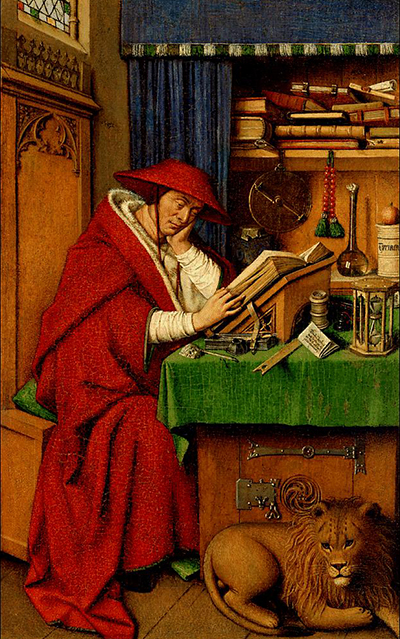Saint Jerome is an important religious figure who was responsible for translating the Bible in around the 4th century, which opened the way for many more cultures to learn and understand the scripture. This depiction of him is known to have come from the workshop of Jan van Eyck.
You will find a number of symbolic additions within this scene that relate directly to the story of this famous individual. For example, we find a lion in the nearest foreground, patiently relaxing besides Saint Jerome's desk. The story goes that he once removed a thorn from a lion's paw, hence its inclusion here. The rest of the scene is fairly well packed in, with the Saint surrounded by various items of furniture within what appears to be his office. A bright green cloth lies over a desk or chest and from here he reads. Behind him are a number of other books which suggests at this being an educated and intelligent man, which he must surely have been. There is also an hourglass which is generally used to symbolise the passage of time, and one's own mortality. There is also a subtle reference to the purity of Mary through the way in which the glass bottle is not impacted by passing light. Some of these items would be hard to spot with your own eyes, as the artwork is actually less than 20cm in height.
Van Eyck created something of a system of iconography and this was passed on to his assistants within his studio. He also called upon the help of his brothers as well, who were skilled artists themselves and often collaborated together in the same projects. Some have argued that actually the portrait is of Cardinal Niccolò Albergati due to several other items within this painting, but that seems unlikely in most people's eyes. The artwork is dated at approximately 1435, at which point Jan van Eyck was still very much alive and could possibly have produced this work himself, but most concensus leads to the conclusion that it was worked on by others who followed in his style. The artwork can now be found in the Medieval and Renaissance department of the Detroit Institute of Arts in Detroit, USA. Some experts have actually dated the piece slightly later, when Jan van Eyck would already have passed away.
This Detroit institution is best known for its display of the extraordinary murals of Diego Rivera, namely the Detroit Industry. Besides that, you can also find some exquisite pieces from European artists such as Franz Marc, Wassily Kandinsky, Edgar Degas, Edvard Munch and William-Adolphe Bouguereau. You will notice that they have managed to collect a broad range of work across many different art movements which helps to ensure that there is plenty to suit most artistic tastes, as well as then many more antiquities elsewhere in the museum which cover other civilisations from right across the entire globe. Van Eyck himself is likely to have inspired many of the others featured here, particularly in his innovative use of oil paint which pushed this medium onwards.




